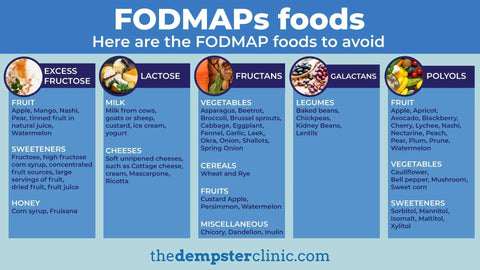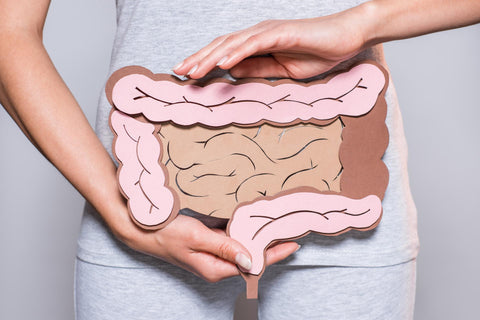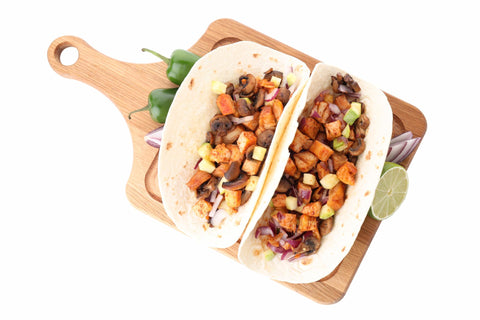Mannitol Foods: Exploring The Benefits and Role in Digestive Health
Have you ever wondered about mannitol foods? Mannitol, a type of sugar alcohol used as a sweetener, is also found naturally in a variety of fruits and vegetables. Mannitol has a lower impact on blood glucose levels compared to regular sugar, making it a popular choice for people with diabetes. However, mannitol consumption also comes with its own set of health considerations. It’s not properly digested and may cause digestive discomfort in some people. This article covers the basics of mannitol foods, how they are absorbed in the body, and the benefits and adverse impacts associated with mannitol food consumption.
What is Mannitol?
Mannitol was first discovered in the secretions of the manna ash tree, hence its name. Initially, it was chiefly found in natural sources, with the manna ash tree's exudate being one of the most notable. Later on, it was identified in various fruits and vegetables, such as mushrooms, seaweeds, and even in some celery and pumpkins. This discovery expanded the use of mannitol in the food and pharmaceutical industries and prompted further research into its benefits and potential health risks.
Chemically, mannitol is a form of sugar alcohol known as a polyol, similar to sorbitol. Mannitol is naturally found in certain fruits and vegetables. Unlike traditional sugars, mannitol is poorly absorbed by the intestines, which can cause digestive problems for some people. Mannitol falls under the Fermentable Oligosaccharides, Disaccharides, Monosaccharides, and Polyols (FODMAP) category - more on that below.
Mannitol is a low-calorie sweetening agent ideal for people with diabetes and is often found in diet foods and confectionery. In clinical settings, mannitol functions as a diuretic and is helpful for its capacity to alleviate increased intraocular and intracranial pressures, particularly following traumatic brain injuries. Mannitol can be identified on food labels simply as mannitol or with the E-number E421.
Mannitol as an Artificial Sweetener
Mannitol is utilised for its sweetening properties in a diverse range of food items. It is a favoured component in sugar-free confectionery and energy-reduced products due to its dental-friendly nature (non-cariogenic) and low caloric content. Despite mannitol's limited solubility, which diminishes the cooling sensation usually present in mint candies and gums, its complete dissolution in a product triggers a pronounced cooling effect.
Commonly featured in chewing gums, mints, frozen desserts, cookies, icings and fillings, mannitol’s ability to resist moisture absorption makes it a valuable ingredient, used as a coating for hard candies and gum. Its pleasant taste and mouthfeel further establish mannitol as a sought-after ingredient for chewable tablets.

Source: https://thedempsterclinic.com/
Mannitol Foods & FODMAPs
FODMAPs, an acronym for Fermentable Oligosaccharides, Disaccharides, Monosaccharides, And Polyols, represent a group of short-chain carbohydrates that are partially absorbed in the small intestine. These sugars can draw water into the intestine and become fermented by gut bacteria, which produces gas. For some individuals, particularly those with sensitive digestive systems or conditions like irritable bowel syndrome (IBS), consuming foods high in FODMAPs can trigger many uncomfortable symptoms.
These digestive symptoms may include:
- Bloating
- Flatulence
- Abdominal Pain
- Changes in bowel habits
Reducing the intake of high-FODMAP foods has been shown to alleviate these symptoms for many people with IBS. This approach may alleviate ongoing symptoms and help calm your digestive system. However, addressing the root cause of gut health problems is the ideal solution.
Medical Uses of Mannitol
There are some specific uses for mannitol in acute and complex health conditions. The evidence primarily points to two main scenarios where mannitol has unique therapeutic benefits. Let's take a look at these below.
Reduces Impacts of Brain Injury
One of the most impressive medical uses for mannitol is in the treatment of ischemic brain injury. An article published in the journal Cell Transplantation outlines the effectiveness of mannitol as an adjunctive treatment in stem cell therapy to regenerate brain tissue. The research shows that mannitol opens the blood-brain barrier, allowing stem cells and other therapeutic agents to cross and promote brain healing. This has been of particular interest in health conditions such as acute brain injuries, cerebral palsy and stroke.
Supports Lung Function in Cystic Fibrosis
Other clinical studies have shown that mannitol has been used as a dry powder for inhalation in patients with cystic fibrosis (CF). People with CF are prone to respiratory system conditions due to the production of thick, sticky mucus in the body. This abnormal mucus can clog the airways, leading to persistent lung infections and diminished lung function. According to a recent study, inhaled mannitol improves lung function and reduces the risk of lung infections and subsequent antibiotic use in both children and adult patients with CF.

How is Mannitol Absorbed in the Body?
Mannitol cannot be fully digested, and so, to a certain extent, malabsorption is common to everyone. Malabsorption refers to partial, rather than complete, absorption of a substance. However, it's in this curious partial absorption that mannitol provides therapeutic benefits. Due to passive diffusion, only a part of mannitol ingested is absorbed into the bloodstream.
Mannitol draws water into the small intestine, which may lead to watery stools, a potential side effect notably when consumed in large amounts. When mannitol reaches the large intestine, it becomes a prebiotic food for gut microbes, aiding in producing short-chain fatty acids (SCFAs), which are beneficial for intestinal health. Mannitol is primarily excreted by the kidneys through urine. After its partial absorption in the digestive system, the kidneys filter mannitol that enters the bloodstream.
As mentioned, if you struggle with IBS or if you are following a low-FODMAP diet, you should consume mannitol foods and mannitol products carefully due to the potential adverse effects.
Mannitol Foods
Foods Containing Mannitol
Mannitol can be found naturally in a variety of foods. Below is a list of common sources:
High-Mannitol Foods
- Seaweed & Kelp
- Button Mushrooms
- Celery
- Fennel
- Leeks
- Cauliflower
- Butternut Squash
- Snow Peas
- Kimchi
- Sauerkraut
- Watermelon
- Peaches
Low-Mannitol Foods
- Oyster Mushrooms
- Broccoli
- Potatoes
- Capsicum
- Carrots
- Butter Lettuce
- Spinach
- Cavolo Nero
- Kale
- Cabbage
- Zucchini
Navigating Mannitol Foods for Digestive Health
If you want to monitor your overall intake of mannitol foods, you may be interested in adopting a low-mannitol or low-FODMAP diet. A high mannitol diet includes foods rich in mannitol, such as seaweed, mushrooms, and certain vegetables. This can lead to increased water drawn into the intestine, producing prebiotic benefits and potential abdominal discomfort and bloating for some people.
On the other hand, a low mannitol diet comprises foods with lower mannitol content, aiming to minimise these gastrointestinal effects while still offering the nutritional and health benefits associated with mannitol-containing foods. Mindfully selecting mannitol foods can be very beneficial, as it helps manage symptom flare-ups while maintaining a balanced and nutritious diet.
Swapping out high mannitol foods for those with lower mannitol content can be a straightforward process that significantly benefits your digestive health. Here are some examples of how to make these swaps in your diet:
- Instead of snacking on watermelon or peaches, which are high in mannitol, consider opting for berries or oranges that offer a sweet taste but have lower mannitol content.
- When preparing dishes that typically include button mushrooms, switch to oyster mushrooms to reduce your mannitol intake without sacrificing flavour or texture in your meals.
- Replace cauliflower in your recipes with broccoli or spinach, allowing you to enjoy similar nutritional benefits with reduced risk of mannitol-related digestive issues.
- For a crunchy snack, instead of reaching for celery or snow peas, try carrots or red capsicum, which are flavorful yet contain less mannitol.
Mannitol Foods: Low-Mannitol Meal Ideas
To help you maintain a healthy diet while keeping mannitol consumption at a minimum, here are some low-mannitol meal ideas to get you started:
- Quinoa Salad with Lemon-Tahini Dressing - A refreshing mix of quinoa, fresh vegetables like cucumbers, tomatoes, and a handful of greens. Dress it up with a lemon-tahini dressing for a flavorful touch.
- Chicken and Vegetable Stir-Fry - Use a variety of mannitol-low vegetables such as bell peppers, broccoli, and snap peas. Sauté these with chicken breast pieces in olive oil and add a savoury sauce for extra taste.
- Zucchini Noodles with Avocado Pesto - Substitute traditional pasta with zucchini noodles for a lower mannitol content. Pair it with a creamy avocado pesto sauce for a nutrient-rich meal.
- Roasted Salmon with Asparagus - Simple yet elegant, this meal involves baking a salmon fillet with a side of asparagus. Season with herbs and lemon juice for an extra kick.
- Sweet Potato and Black Bean Tacos - Fill your tacos with roasted sweet potatoes and black beans. Top with fresh lettuce, diced tomatoes, and a dollop of Greek yoghurt for a fresh, satisfying meal.
Integrating these low-mannitol meals into your diet allows you to enjoy a diverse range of flavours while minimising the risk of digestive discomfort.

High Mannitol Consumption Risks
While mannitol is relatively benign, naturally occurring and well tolerated by the larger population, high consumption carries risks and contraindications that should not be overlooked.
The most common adverse effect that high mannitol consumption causes is osmotic diarrhoea. Mannitol draws water into the gut, and consuming mannitol at levels exceeding 20g per day increases the risk of diarrhoea. For those with a sensitivity or intolerance to mannitol, symptoms such as bloating, gas, and abdominal discomfort can be exacerbated.
Mannitol is also contraindicated in the following conditions:
- Anuria: Loss of urine production
- Severe Hypovolaemia: A critical condition characterised by a decrease in blood volume.
- Severe Pulmonary Oedema: Excessive fluid accumulation in the lungs
Being Mindful With Mannitol Foods
Understanding how your body reacts to different foods can guide you to the optimal amount beneficial for your health without upsetting your belly. Mannitol foods are typically very healthy and can provide many benefits as part of a balanced diet. However, it's essential to approach their consumption mindfully, especially if you suffer any gastrointestinal symptoms as discussed. Furthermore, given its role as an osmotic laxative in higher doses, it’s advisable to consume mannitol-containing foods in moderation. It's always important to appreciate the advantages of mannitol foods and enjoy mindful consumption to ensure they align with your health goals and dietary needs. If you need further advice, consult a trusted health provider for more information.
Article References
Burness, C. B., & Keating, G. M. (2012). Mannitol dry powder for inhalation: in patients with cystic fibrosis. Drugs, 72(10), 1411–1421. https://doi.org/10.2165/11208950-000000000-00000
Chen, M., Zhang, W., Wu, H., Guang, C., & Mu, W. (2020). Mannitol: physiological functionalities, determination methods, biotechnological production, and applications. Applied microbiology and biotechnology, 104(16), 6941–6951. https://doi.org/10.1007/s00253-020-10757-y
Chu, C., Jablonska, A., Gao, Y., Lan, X., Lesniak, W. G., Liang, Y., Liu, G., Li, S., Magnus, T., Pearl, M., Janowski, M., & Walczak, P. (2022). Hyperosmolar blood-brain barrier opening using intra-arterial injection of hyperosmotic mannitol in mice under real-time MRI guidance. Nature protocols, 17(1), 76–94. https://doi.org/10.1038/s41596-021-00634-x
Gonzales-Portillo, G. S., Sanberg, P. R., Franzblau, M., Gonzales-Portillo, C., Diamandis, T., Staples, M., Sanberg, C. D., & Borlongan, C. V. (2014). Mannitol-enhanced delivery of stem cells and their growth factors across the blood-brain barrier. Cell transplantation, 23(4-5), 531–539. https://doi.org/10.3727/096368914X678337
Kareemi, H., Pratte, M., English, S., & Hendin, A. (2023). Initial Diagnosis and Management of Acutely Elevated Intracranial Pressure. Journal of intensive care medicine, 38(7), 643–650. https://doi.org/10.1177/08850666231156589
Wakai, A., McCabe, A., Roberts, I., & Schierhout, G. (2013). Mannitol for acute traumatic brain injury. The Cochrane database of systematic reviews, 2013(8), CD001049. https://doi.org/10.1002/14651858.CD001049.pub5
Witherspoon, B., & Ashby, N. E. (2017). The Use of Mannitol and Hypertonic Saline Therapies in Patients with Elevated Intracranial Pressure: A Review of the Evidence. The Nursing clinics of North America, 52(2), 249–260. https://doi.org/10.1016/j.cnur.2017.01.002

